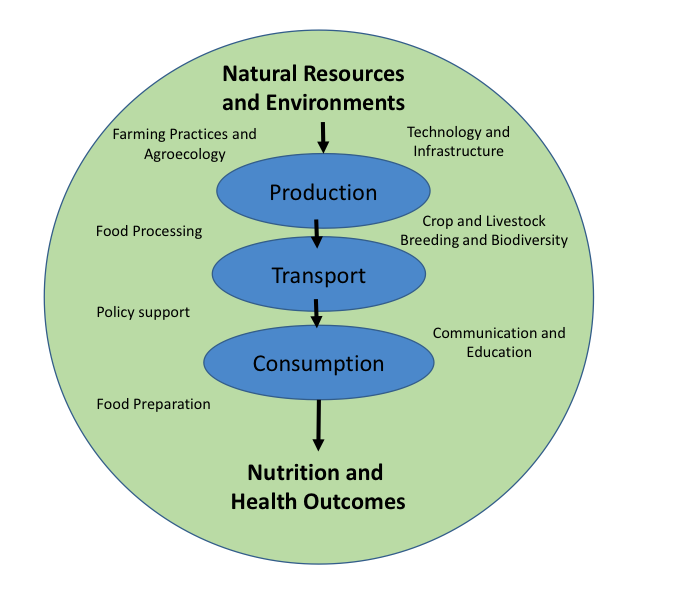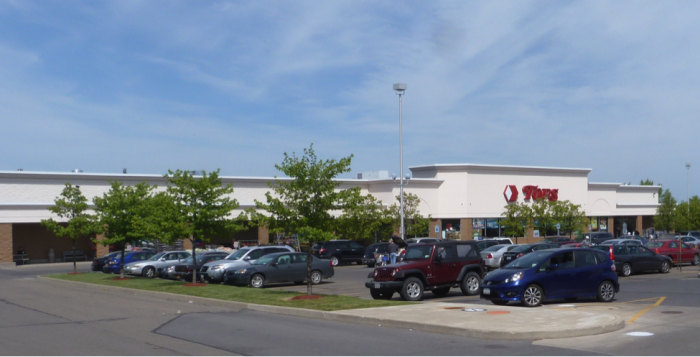Food Systems: Environments, Production, Distribution, and Household Utilization of Food
The introductory section below is adapted from "Chapter 3: The food system and household food security” at the document website of the United Nations Food and Agriculture Organization (FAO).
This section attempts to describe the parts of a food system in basic terms, starting from the standpoint of the systems approach. It begins, "the perception underlying the systems approach is that the whole is greater than the sum of its parts. Any situation is viewed in terms of relationships and integration. A food system may thus include all activities related to the production, distribution, and consumption of food that affect human nutrition and health (see Figure 10.1.1, which is reproduced from module 1).
Food production comprises such factors as the use of land for productive purposes (land use), the distribution of land ownership within communities and regions (land tenure), soil management, crop breeding and selection, crop management, livestock breeding and management and harvesting, which have been touched on in previous modules. Food distribution involves a series of post-harvest activities including the processing, transportation, storage, packaging, and marketing of food as well as activities related to household purchasing power, traditions of food use (including child feeding practices), food exchanges and gift-giving and public food distribution. Activities related to food utilization and consumption include those involved in the preparation, processing, and cooking of food at both the home and community levels, as well as household decision-making regarding food, household food distribution practices, cultural and individual food choices, and access to health care, sanitation, and knowledge.
Among the components of the food system, e.g. food processing, communication, and education, there is substantial overlap and interlinkage. For example, household decision-making behavior with regard to food is influenced by nutrition knowledge and by cultural practices with regard to food allocation within the household as well as by purchasing power and market prices."

Food systems are further embedded in environments and societies (thus, both natural and social/political contexts) which differ according to a variety of factors such as agroecology (the composition of the local agroecosystem, see previous modules), climate, social aspects, economics, health, and policy. The model presented in Figure 10.1.1 above is useful in conceptualizing the various activities that determine food security and nutritional well-being and the interactions within the food system."
Two important features that we want to emphasize in the passage above from the FAO are first, the fact that food systems involve processes at multiple scales (e.g. local agroecosystems, government policy at a national scale, international research and technology development), which eventually have many impacts at a household scale, either in the livelihoods of food producers (who gain income from the food system and also consume food); and also for consumers around the world. Second, criteria with which we should evaluate food systems are their ability to deliver nutrition and health outcomes (see e.g. module 3), and also the sustainability of natural resources and environments, which we will consider in module 10.2. We note that these criteria of environmental sustainability and health are at opposite ends of this "conveyer belt" model of food systems, where the food system "conveyer belt" can be said to deliver nutrition and health outcomes by transforming the inputs from natural resources and environments. These health and nutrition outcomes are associated with the concept of food security (sufficient access to appropriate and healthy food) which was introduced in module 3 and will be further explored in module 11. Human health and environmental sustainability correspond roughly to the positive objectives that we conceive of for the human system and natural systems, respectively: health and equitable nutrition (or food security) in the human system, and environmental sustainability of natural systems. A final observation from Fig. 10.1.1 is that food systems are ubiquitous and touch on all aspects of human societies. We are all participants in food systems, either as producers, consumers, in the distribution or in other myriad ways.
Activate Your Learning: Food's Journey in the Food System

Food systems comprise the interacting parts of human society and nature that deliver food to households and communities (see the previous page), and can be used to understand food in its relation to the earth system. To better understand food systems, in the exercise below you'll be asked to consider a familiar food of your choice, and the journey this food takes from where it is produced to the meals that we consume every day. Within the food supply chain for this food, you'll be asked to distinguish between social (human system) aspects and environmental (natural system) aspects of that product's food production and supply chain.
Activate Your Learning Activity:
In the blanks below, fill in the blanks regarding the supply chain for food products. You can also download the worksheet for filling in offline, or as part of a classroom activity. As depicted in Fig. 10.1.3, you’ll need to give the origin, some intermediate destinations, and then the final consumption point for the food product. Then you should think of some social or human system dimensions of the production, supply chain, or consumption of this product, as well as some ecological or natural system dimensions and fill in the corresponding blanks. Do this first for a product familiar to you, whose supply chain you either know about or can research quickly (part 1). Then repeat the activity for a food product in the online introductory video from the first page of this module, about food systems in Vietnam (part 2). When you are done with each part you can click on the ‘answers’ link in the below each part, and see how your answers match up.

Fill in the blanks below. If you are doing this online, just note your answers on a piece of paper regarding the food product you have chosen, or download the worksheet. When you are done you can click on the ‘answers’ link below to see some possible examples and see if your answers match up with these answers.
- Food product ______________________________
- Food supply Chain:
- Source: Where main raw material is produced, fished, hunted: ___________________________
- Intermediate destination 1: ___________________________ (e.g processing plant, washing, trucking, warehouse, etc.)
- Intermediate destination 2: ___________________________ (e.g processing plant, washing, trucking, warehouse, etc.)
- Intermediate destination 2: ___________________________ (if needed)
- Consumption point: ___________________________
- Up to three social or human system dimensions of this food chain (e.g. policy, economic, or cultural factors associated with the production and consumption of this food, recall the Human System factors in a Coupled Human Natural Framework, module 1.2)
- _______________
- _______________
- _______________
- Up to three ecological or natural system dimensions of this food chain: (ecological factors would include crop and animal species, agroecosystems, climate, water, and soil influences on food production):
- _______________
- _______________
- _______________
Example answers
(These may be a good deal more complete than your examples but give a sense of the range of possible answers)
Example Answer 1 - frozen, breaded fish filet from a local supermarket:
Click for the answer.
- Frozen, breaded fish filet (i.e., the fish part)
- Food supply chain:
- Fishing boat in Atlantic, Chinese, or Alaskan Fishery, e.g., including flash-freezing.
- Preparation facility in Canada or U.S.
- Cold chain shipping / Supermarket
- Kitchen oven and dining table for food preparation and consumption.
See some fascinating details about the production process, in How It's Made.
- Social dimensions:
- Financing, organization, and contracts for a fishing fleet and processing
- Government and fishing communities’ agreements on fisheries regulation to avoid overfishing.
- Supermarket companies
- Ecological dimensions:
- The wild fish species itself
- Food sources for the fish (algae, other fish)
- Changing ocean temperatures and conditions with climate change
Example Answer 2 - Bagel or bread from a local bake or coffee shop:
Click for the answer.
- Baked good (i.e., flour it is made from)
- Food supply chain:
- Farm in Midwest or Western U.S.
- Grain elevator purchasing and storing grain
- Flour production facility
- Café or restaurant kitchen (may be a large centralized kitchen for a chain restaurant) and coffee shop table for consumption.
- Social dimensions: (could include any of these)
- Farm enterprise belonging to a farm family or company – organization of production labor and agroecosystem management.
- Supply chains and companies for fertilizers, seed, and other agricultural inputs
- Government policies regulating subsidies to farmers, tax on diesel fuel, pollution regulations etc.
- Grain commodity markets and corporations
- Ecological dimensions:
- Domesticated wheat species (Triticum aestivum)
- Prairie soils (Mollisols) with inherent good qualities and climate for wheat growing
- Soil bacteria breaking down organic matter, releasing nutrients, accessing fertilizer N and releasing nitrous oxide.
- Bread yeast and/or sourdough bacteria used in bread making.
Exercise 2:
Recall the video celebrating world food day 2013, World Food Day 2013 Video: the Vietnamese “Garden, Pond, Livestock Plan” (V.A.C) food system". You may want to quickly skim the video again and note the food pathways that foods are following in these systems. Then choose either a product that is consumed within the household that appears in the video or one that is sold outside the household (some products fit into both categories). Fill in the same set of production and transport steps for this product as you did in part 1, as well as some social and ecological aspects. You can use a piece of scrap paper or the downloaded worksheet. Note that a product consumed in this farming household may have a very short food supply chain!
Look at the following worksheet and fill in the blanks corresponding to the blanks below. When you are done you can click on the ‘answers’ link to see some possible examples and see if your answers match up with these answers.
- Food product ______________________________
- Food supply Chain:
- Source: Where main raw material is produced, fished, hunted: ___________________________
- Intermediate destination 1: ___________________________ (e.g processing plant, washing, trucking, warehouse, etc.)
- Intermediate destination 2: ___________________________ (e.g processing plant, washing, trucking, warehouse, etc.)
- Intermediate destination 2: ___________________________ (if needed)
- Consumption point: ___________________________
- Up to three social or human system dimensions of this food chain (e.g. policy, economic, or cultural factors associated with the production and consumption of this food, recall the Human System factors in a Coupled Human Natural Framework, module 1.2)
- _______________
- _______________
- _______________
- Up to three ecological or natural system dimensions of this food chain: (ecological factors would include crop and animal species, agroecosystems, climate, water, and soil influences on food production):
- _______________
- _______________
- _______________
Example Answers
Example for the Vietnam VAC food system example:
Click for the answer.
- Food Product: Fish from the fish pond in the video
- Food supply chain (if sold):
- Brought from pond
- Transported by cart or truck to city
- Sold in market
- Prepared at home
- Brought from pond
- Prepared and eaten.
- Social dimensions: (could include any of these)
- Farm enterprise belonging to a farm family – production roles of family members
- Government policies promoting choice by farmers of what to grow and the ability to market it (note as a communist government there was a time when this was not allowed)
- Government and community efforts to promote and adapt the V.A.C. food production methods.
- The organization of local markets and food sellers that allows farmers to sell products.
- Ecological dimensions:
- Fish species e.g. carp
- Pond / Garden agroecosystem
- Recycling of organic wastes from fish production into soils
- Rainy climate/river delta geography and abundant water for fish and crop production.
